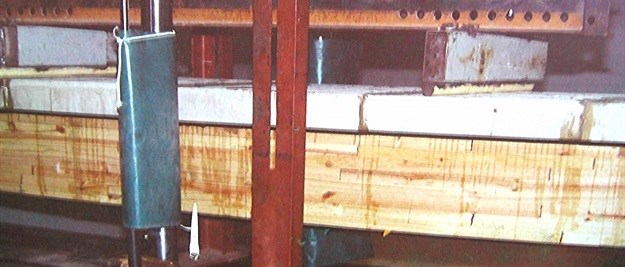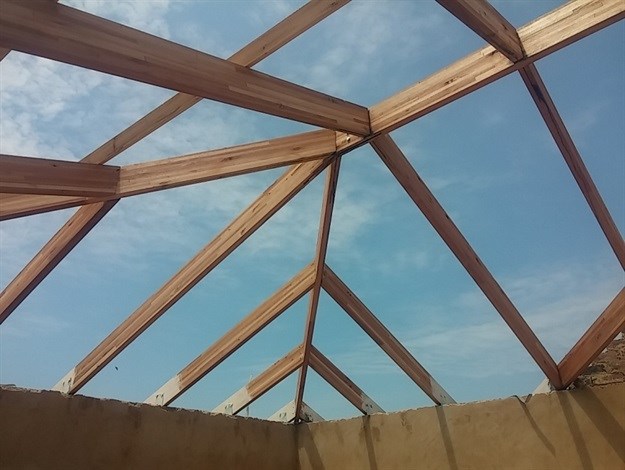The South African construction trade can benefit from making use of laminated timber beams for structural applications, says Abe Stears, managing director of the South Africa Technical Auditing Services (SATAS).
SATAS offers certification and inspection services for the timber, chemical, metallurgical and plastic pipe industries. Stears also issues a word of caution with respect to manufacturing and using this material correctly and according to national regulations.

This particular laminated timber beam did not make the grade.
“Unfortunately, not many people know how to use structural laminated beams properly, and in some instances they are used in structural applications for their aesthetic appeal without any consideration for their load bearing ability or capacity,” he remarks.
Random tests conducted on laminated timber beams at the University of Pretoria by Professor Walter Burdzik revealed that a large percentage of such laminated timber beams did not comply with the MOR (i.e. bending strength) and MOE (Modulus of Elasticity) requirements for stress grade five as published in SANS 10163 parts one and two, which govern both the allowable stress design and limit-states design of the structural use of timber.
What is structural laminated timber or ‘glulam’?
A laminated timber or ‘glulam’ beam is an engineered product made up of layers of wood (usually pine or eucalyptus) that have been glued together with an approved adhesive specifically designed for structural applications. The various components that go into making a laminated timber beam must meet certain requirements prior to assembly.
Firstly, proper drying, grading/selection and machining of the timber to be used are very important considerations. The finger joints in boards to be used in laminated beams must also comply with the requirements set out in SANS 10096, which governs the manufacture of finger-joints in structural timber.
Furthermore, the adhesive used to bind the wood together must be selected for the appropriate application class for which the laminated timber beam will be used. Adhesive systems are specially designed for use in these specific application classes, which range from exposed exterior to interior dry.
“A structural beam manufactured with adhesive designed for interior dry use will not last long if used in an exterior application. Proper manufacturing process control is vital, as the use of the correct adhesive and timber will prove worthless if not correctly applied,” Stears remarks, adding that, “Important factors and conditions, such as timber moisture content and adhesive manufacturer requirements, like press time, pot life and spread rate, are vital to ensure a quality end product.”

Machine testing for grade verification
Once the manufacturing process is complete, grade compliance needs to be established or verified. This is achieved by means of a proof load test, which records the relevant data to determine compliance with the grade requirements on strength and MOE. Once this has been completed, adhesive bond integrity tests are performed on small samples to determine compliance in the total manufacturing process.
Certification of structural laminated timber
“It is important to note that all timber used for structural purposes in South Africa must meet the strength requirements for stress grade five as a minimum, which means that any timber, including laminated timber units, that does not meet the relevant grade requirements is not appropriate or safe for use as structural timber,” says Stears. “Only a few laminated timber manufacturers in South Africa are certified by an accredited product certification body, like SATAS and the South African Bureau of Standards (SABS), for the manufacture of laminated beams to the requirements of SANS 1460 for laminated timber.”
Note: Both SATAS and the SABS are the only two bodies accredited by the South African National Accreditation Systems (SANAS) to carry out certification on structural laminated timber.
Certified laminated timber beams are manufactured under controlled conditions and processes, and have to be marked with certain information, such as the stress grade, certification mark of the certifying body, trade name (of the manufacturer) and application class (interior or exterior).

Certified laminated timber beams are manufactured under controlled conditions and processes, and have to be marked with certain information, such as the stress grade, certification mark of the certifying body, trade name and application class. Image credit: RSB Beams.
According to Stears, “The manufacture of structural laminated beams in compliance with SANS 1460 is a costly process, which is why some unscrupulous contractors may make use of inferior imported or ‘backyard’ products that do not meet the required standards for strength or quality for structural applications. The knock-on effects of this are potentially devastating.”
“If a cheaper alternative product is used, failures could result, but these would more than likely only occur a few years after construction, and in most instances responsibility of repair and related costs would befall the unsuspecting owner,” he says.
“Laminated timber is a viable resource and an intelligent choice for structural construction applications, but the use thereof without traceability and product certification is a recipe for disaster,” Stears affirms. “While the informed homeowner or project developer can aid in the demand for above-board product, it is ultimately the responsibility of architects, designers and engineers to insist on certified laminated timber beams for use in structural applications,” he concludes.


































